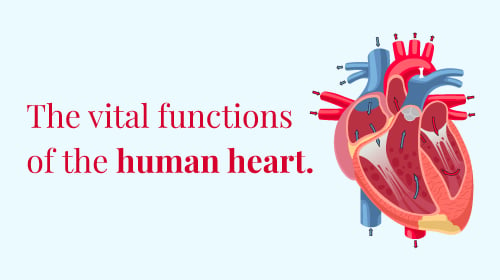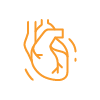What is the Function of the Heart
February 21, 2025

The heart is a muscular organ in the chest, right behind and to the left of the breastbone. It is mostly the size of a closed fist in measurement. The main function of the heart is to pump blood to all parts of the body through the network of blood vessels called the arteries and veins. These together are known as the cardiovascular system.
The heart is made up of four chambers. While the upper two chambers are called the atria, the lower ones are called the ventricles. The right heart is a combination of the right atrium and right ventricle, and the left heart comprises the left atrium and ventricle. The various other chambers of the heart are separated by a partition each of them is called a septum.
- The right atrium collects deoxygenated blood from the body and transports it to the right ventricle.
- The right ventricle receives blood from the right atrium and pumps it to the lungs to oxygenate it.
- The left atrium transports oxygenated blood from the lungs to the left ventricle.
- The left ventricle is the heart’s most powerful chamber. It distributes oxygen-rich blood throughout the body.
The flow of blood into the heart, within the chambers, and out of it is guarded by the four valves in the heart. The coronary arteries, running along the surface of the heart, supply the heart with nutrition and oxygen. It is the well-supplied network of nerve tissues that aids in the rhythmic heartbeat. The pericardium is a fluid-filled sac in which the heart is enclosed. It is the pericardium that produces a liquid that keeps the heart from creating friction with the other organs in its surroundings.
Some Common Diseases Related to the Heart
- Coronary heart disease (CAD) – The narrowing of the arteries providing blood to the heart is referred to as coronary heart disease.
- Stable angina pectoris – A simple chest pain due to the supply of insufficient blood to the heart, caused by complex physical activity.
- Unstable angina pectoris – Unstable angina pectoris is a dangerous disorder since it might precede a heart attack.
- Heart attack – Due to the lack of oxygen, some of the heart muscles die when the coronary artery is suddenly blocked.
- Arrhythmia – An abnormal beating of the heart which may interfere with the normal process of the heart pumping blood to the organs.
- Congestive heart failure (CHF) – It will occur when the heart is unable to efficiently pump blood to bodily tissues.
- Cardiomyopathy – A cardiac muscle illness that causes the heart to be excessively big, thickened, and stiff. As a result, the heart’s ability to pump blood is weakened. Cardiomyopathy can lead to heart failure and other serious conditions.
- Cardiac arrest – A sudden dysfunction of the heart is known as cardiac arrest.
- Pericarditis – It is an inflammation of the pericardium (the outer lining of the heart), often caused by infection or autoimmune disorders that lead to chest pain and discomfort.
- Rheumatic Heart Disease – A heart condition caused by untreated streptococcal infections, leading to permanent damage to the heart valves and affecting blood flow.
The Functions of the Heart
The heart is the most crucial organ of the circulatory system, which is predominantly responsible for delivering blood and nutrients to all parts of the body. The cardiac cycle ensures that blood is circulated throughout the body. The oxygen distribution process begins when oxygen-free blood enters the heart via the right atrium, travels to the right ventricle, enters the lungs for oxygen refill and carbon dioxide release, and then returns to the left chambers for redistribution. The tricuspid and mitral valves close during systole; the aortic and pulmonary valves close during diastole. In measuring blood pressure, the systole-diastole connection is used. Examining the pulse rate is another approach to determining the heart’s regular functioning.
How to Protect Your Heart from Disease
Adopt a heart-healthy lifestyle to protect yourself from cardiovascular disease and enhance your overall health.
- Follow Medical Advice – Adhere to your doctor’s recommendations and take medications as prescribed to manage existing conditions.
- Maintain a Healthy Weight – Keep your weight within a healthy range based on your age, sex, and body type.
- Eat a Balanced Diet – Add plenty of fruits, whole grains, vegetables, healthy fats, and lean proteins in your meals for a heart-healthy diet. Reduce processed foods, trans fats, and added sugars.
- Exercise Regularly – Engage in at least one-fifty minutes of moderate exercise or seventy-five minutes of intense activity per week to strengthen your heart.
- Limit Alcohol Intake – If you consume alcohol, do so in moderation to avoid its negative effects on heart health.
- Reduce Sodium Consumption – Lower salt intake to maintain healthy blood pressure levels and prevent hypertension.
- Manage Stress Effectively – Practice meditation, deep breathing, or journaling to cope with stress in a healthy way.
- Quit Smoking and Avoid Tobacco – Smoking affects blood vessels and increases the risk of heart disease. Quitting smoking and avoiding tobacco is one of the best things you can do for your heart.
- Get Enough Sleep – Ensure you get a quality sleep of 7–9 hours each night to maintain heart health and overall well-being.
If you have a condition that affects your heart, follow your healthcare provider’s treatment plan. It is important to follow the prescribed medication regimen. You can make changes to your lifestyle to help keep your heart healthy. You can maintain a healthy weight for your sex and age. Drink alcohol in moderation to enjoy its benefits while avoiding any negative consequences. A heart-healthy diet includes plenty of fruits, vegetables, whole grains, and regular exercise. Limit sodium intake. Stress can be managed with healthy strategies like meditation or journaling. If you want to avoid health problems, stop smoking and using tobacco products.
Frequently Asked Questions
1. How many vessels are in the heart?
The heart pumps a lot of blood throughout the body every day. It does this through five main types of blood vessels: arteries, arterioles, capillaries, venules, and veins.
2. What is the function of vessels in the heart?
Blood vessels transport blood from the heart to the rest of the body, ensuring that organs and tissues receive the oxygen and nutrients needed for proper function.
3. How does blood flow from the heart through the blood vessels?
Blood enters the right atrium from the body and moves into the right ventricle. It is then pushed into the pulmonary arteries in the lungs. After picking up oxygen, the blood travels back to the heart through the pulmonary veins and into the left atrium. From there, the blood travels to the left ventricle and the body’s tissues through the aorta.
4. What is the largest artery in the heart?
The aorta is the largest blood vessel in your body. It measures over a foot in length and an inch in diameter at its widest point.
5. What is the function of the pacemaker in the heart?
The function of the pacemaker in the heart is to regulate and control the heart’s rhythm and rate by generating electrical impulses.







